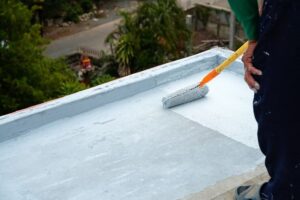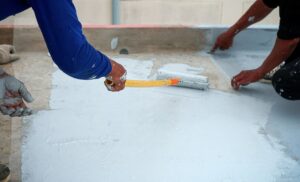RoofCont provides expert roofing, siding and contractor services, specializing in installations, repairs, and replacements for residential and commercial properties.
RoofCont provides expert roofing, siding and contractor services, specializing in installations, repairs, and replacements for residential and commercial properties.

Choosing the proper adhesive to use with your roofing project is of utmost importance as regards the life span and functionality of EPDM Roof Glue as well as TPO rubber roofs. This paper covers the EPDM Roof Glue and TPO roofing in terms of finer details of these roofing products, the type of adhesives, which can be used and how to go about the selection of the right product like a 1 gallon bonding adhesive to make your roofing process fruitful and having a roof repair as an accomplishment.
EPDM roofing is a long-lasting synthetic roof membrane made of a rubber roofing that is characterized by its high capability to resist UV luminosity, weather, and temperature. EPDM rubber roofing is an elastic and durable roofing solution to any roofing.

The TPO membrane roofs have acquired a reputation of reflecting heat, being energy efficient and withstanding puncture, tears and chemical attack. TPO roofing membranes are commonly used to provide economical and long lasting alternative to other conventional roofing products.
Although both TPO and EPDM Roof Glue roofing membranes are single layers, the materials that go into their makeup are different and their properties differ. EPDM is characterized to be flexible, and have a proven life, whereas TPO is more energy efficient, and insusceptible to some chemicals. The choice of EPDM or TPO is based on a variety of local factors in a project, and variables are the climatic aspect, financial limitations, and energy performance where the project owner wants certain levels of performance in terms of energy. Take into consideration as well the right adhesive compatibility.
Selection of the EPDM Roof Glue adhesive is essential in guaranteeing a strong bond which is durable bond. Solvent-based and water-based adhesive that are prepared to bond EPDM to a range of different substrates are available. EPDM Roof Glue adhesives temperature and UV radiation cause stress to the sealants, so EPDM adhesives are required to achieve the desired adhesion to be resistant to the external conditions.
The process of TPO membranes selection and the adhesive materials to use is associated with considering environmental conditions and the type of the substrate material. The adhesive should be able to match with to the TPO membrane and give off a bond that is strong and long-lasting. Flexibility and greater UV resistance is also provided by some TPO adhesives.
Water-based adhesives tend to contain fewer VOCs and to be environmentally aware, whereas solvent-based adhesives can present better bonding strength and cold performance. The decision to use water-based or solvent-based is normally affected by the SCAQMD regulations and the safety of the roofer.
The most important thing when using 1 gallon bonding adhesive is to have the relevant surface preparation. The surface has to be clean, dry, and non-polluted. The adhesion can be greatly improved by priming the surface prior to positioning the EPDM adhesive.
EPDM adhesive has to be applied with great precision. You start by mixing the 1 gallon bonding adhesive completely to give a consistent mix. A roller or a brush should be used to apply an adhesive to both the substrate and the EPDM membrane equally and uniformly. Prior to bonding the surfaces together, also allow the solvent-based or water-based adhesive to tack dry as suggested by the manufacturer. Sufficient use of application techniques is essential to establishing a quality, robust glue union.
Allow sufficient time for the adhesive to fully cure before exposing the EPDM roof to any stress or environmental conditions. Following the manufacturer’s recommendations for drying and curing is essential.
Primers play a crucial role in enhancing the bond between the EPDM rubber roofing and the substrate. Improving adhesion and ensuring a stronger, more durable bond. The use of an appropriate primer, like Firestone, can significantly extend the lifespan of the EPDM roof.
Selecting the appropriate sealant for EPDM and TPO roof systems is critical for maintaining a waterproof and airtight seal. For EPDM, use sealants specifically formulated for EPDM membrane. For TPO, choose sealants designed to adhere to TPO membrane.

Low VOC and water-based adhesive options are increasingly favored in the industry due to the impact of Volatile Organic Compounds (VOCs) in roofing adhesives.
Roofers should prioritize safety by adhering to strict guidelines when using both solvent-based and water-based adhesives, ensuring adequate ventilation, and wearing appropriate personal protective equipment.
Implementing best practices for environmentally friendly roofing involves selecting low VOC adhesives, sealants, and primers for EPDM and TPO installations.
Selecting the appropriate adhesive for EPDM and TPO roofs requires careful consideration of several key factors. First, ensure compatibility between the adhesive and the membrane material, whether EPDM rubber or TPO. Evaluate the substrate to which the membrane will be bonded, such as plywood or other porous surfaces. Choose an adhesive formulated for bonding EPDM to that specific material. Consider environmental conditions, including temperature and moisture levels, as well as VOC regulations. Select an adhesive with the appropriate performance characteristics.
Choosing the right adhesive for EPDM and TPO roofing projects is essential for ensuring long-term performance and durability. Prioritize compatibility, adhesion strength, and compliance with SCAQMD and VOC regulations.
Deprecated: File Theme without comments.php is deprecated since version 3.0.0 with no alternative available. Please include a comments.php template in your theme. in /home/u737183660/domains/roofcont.com/public_html/blog/wp-includes/functions.php on line 6131